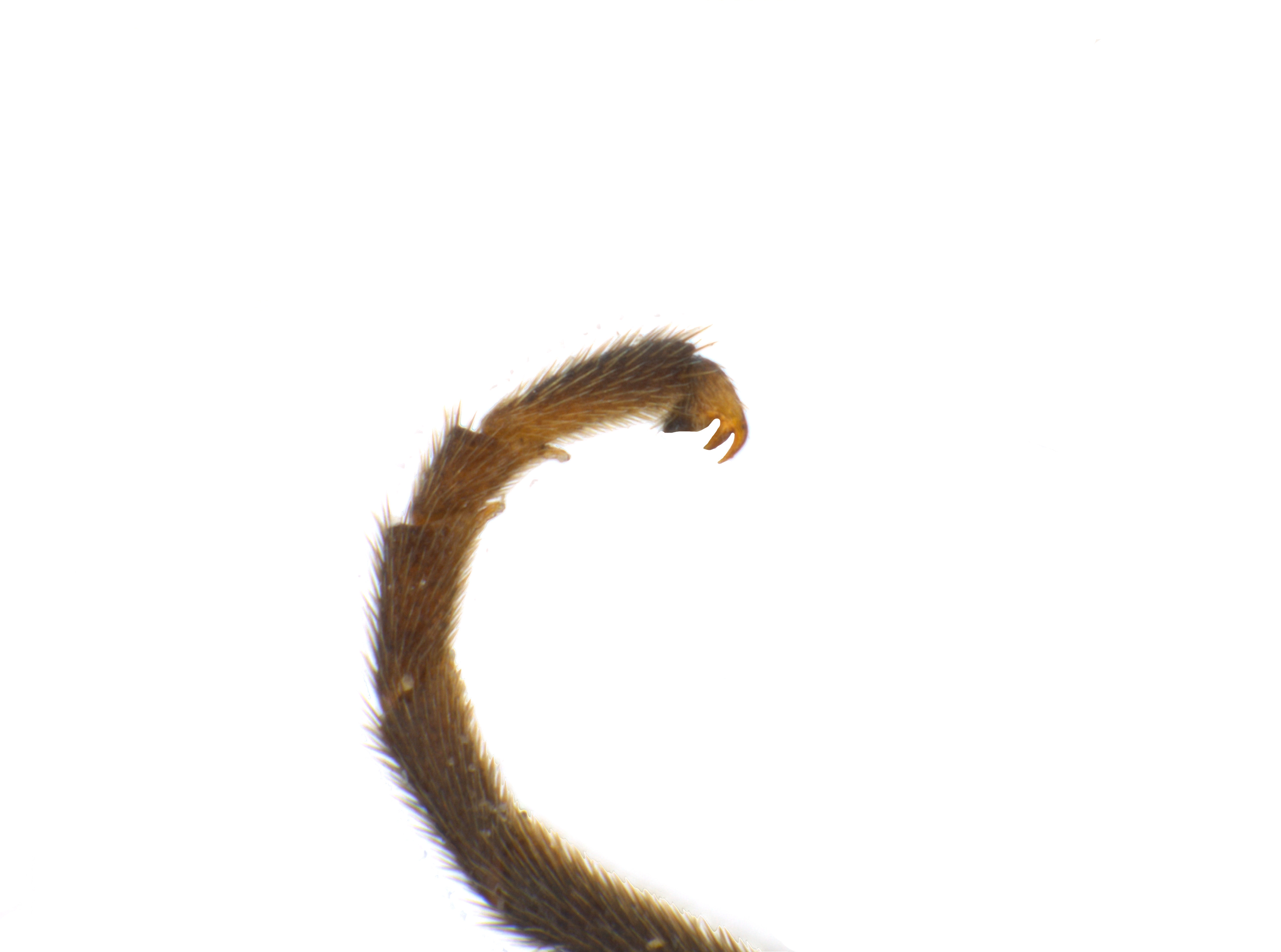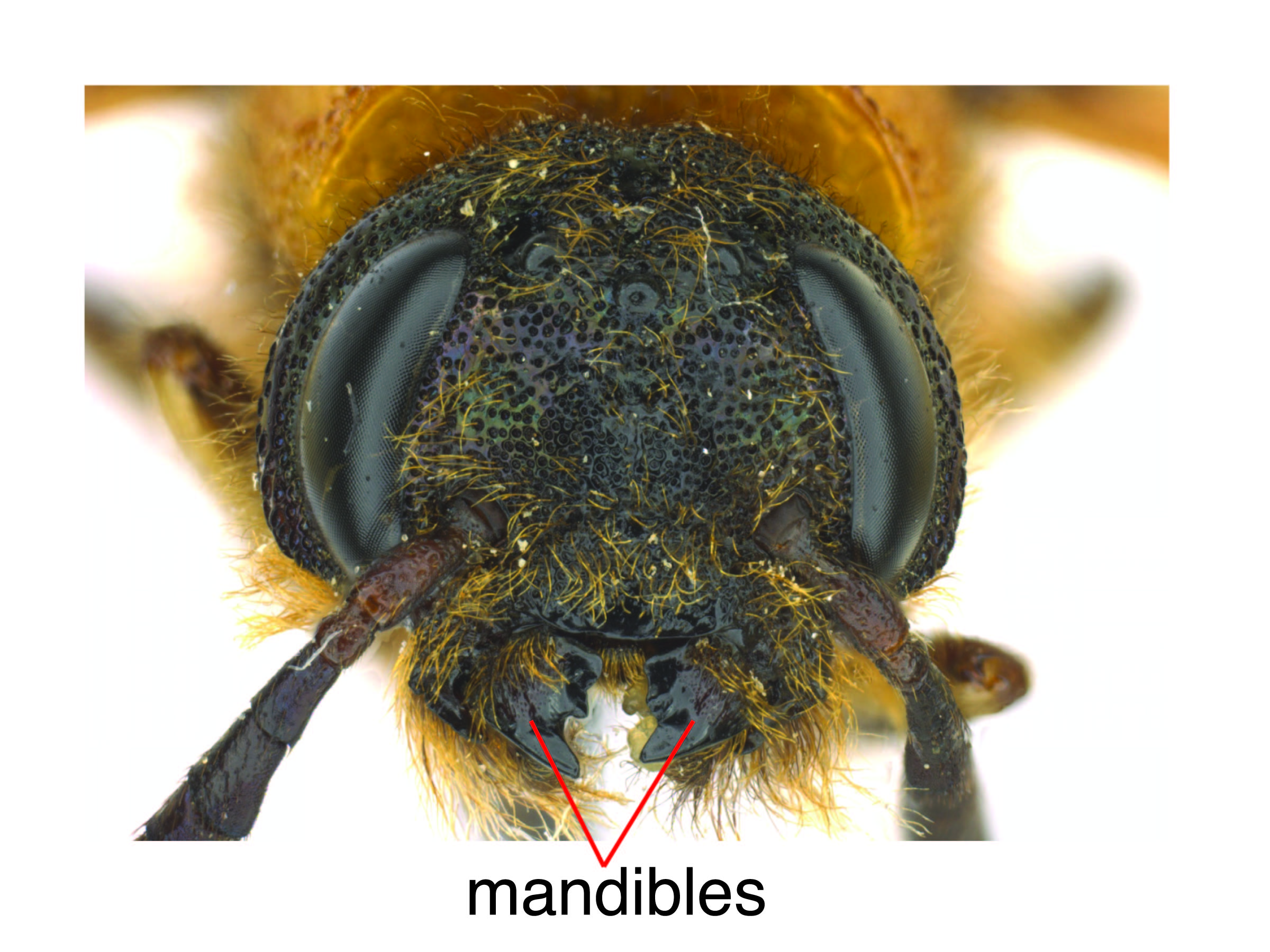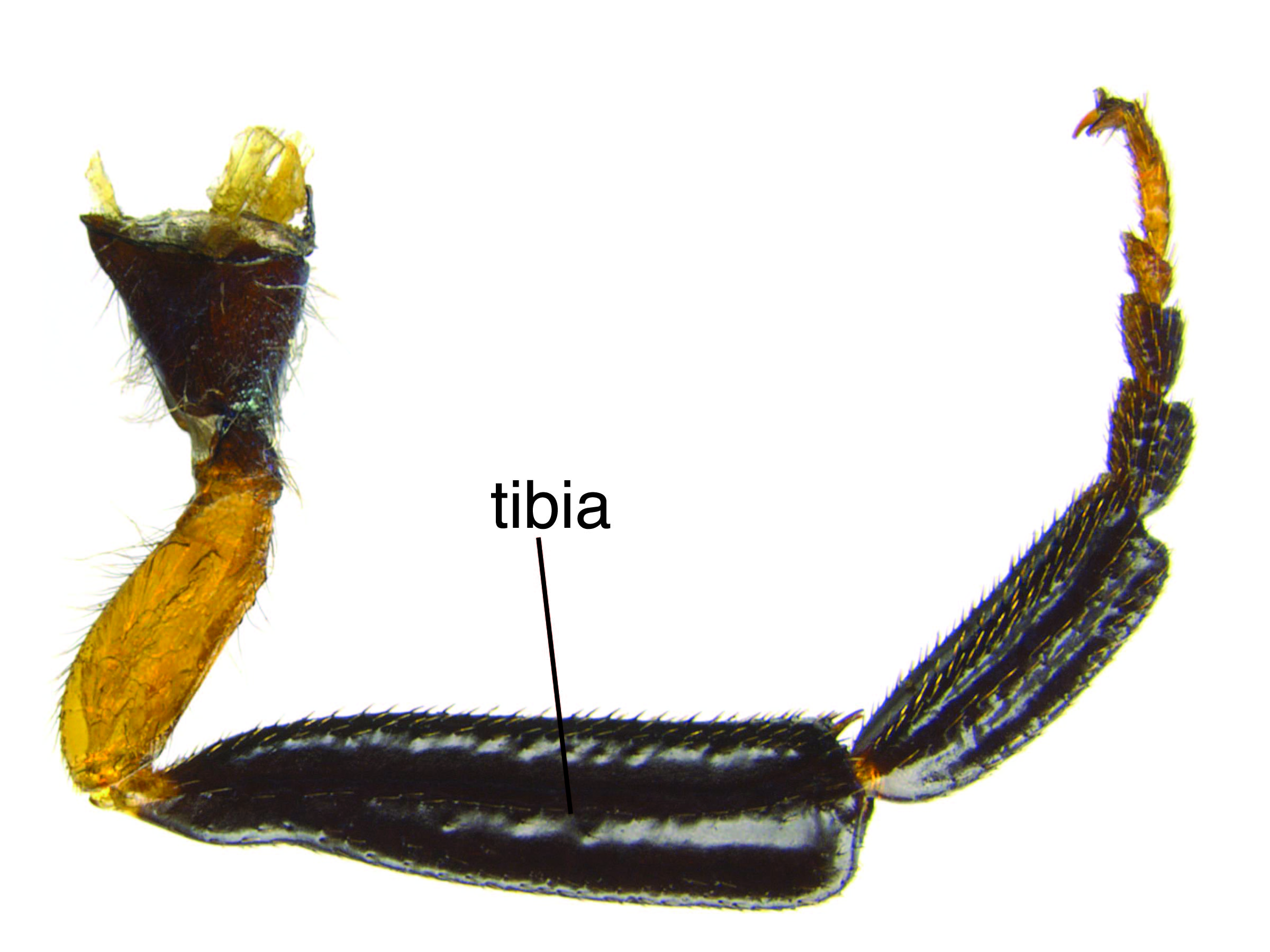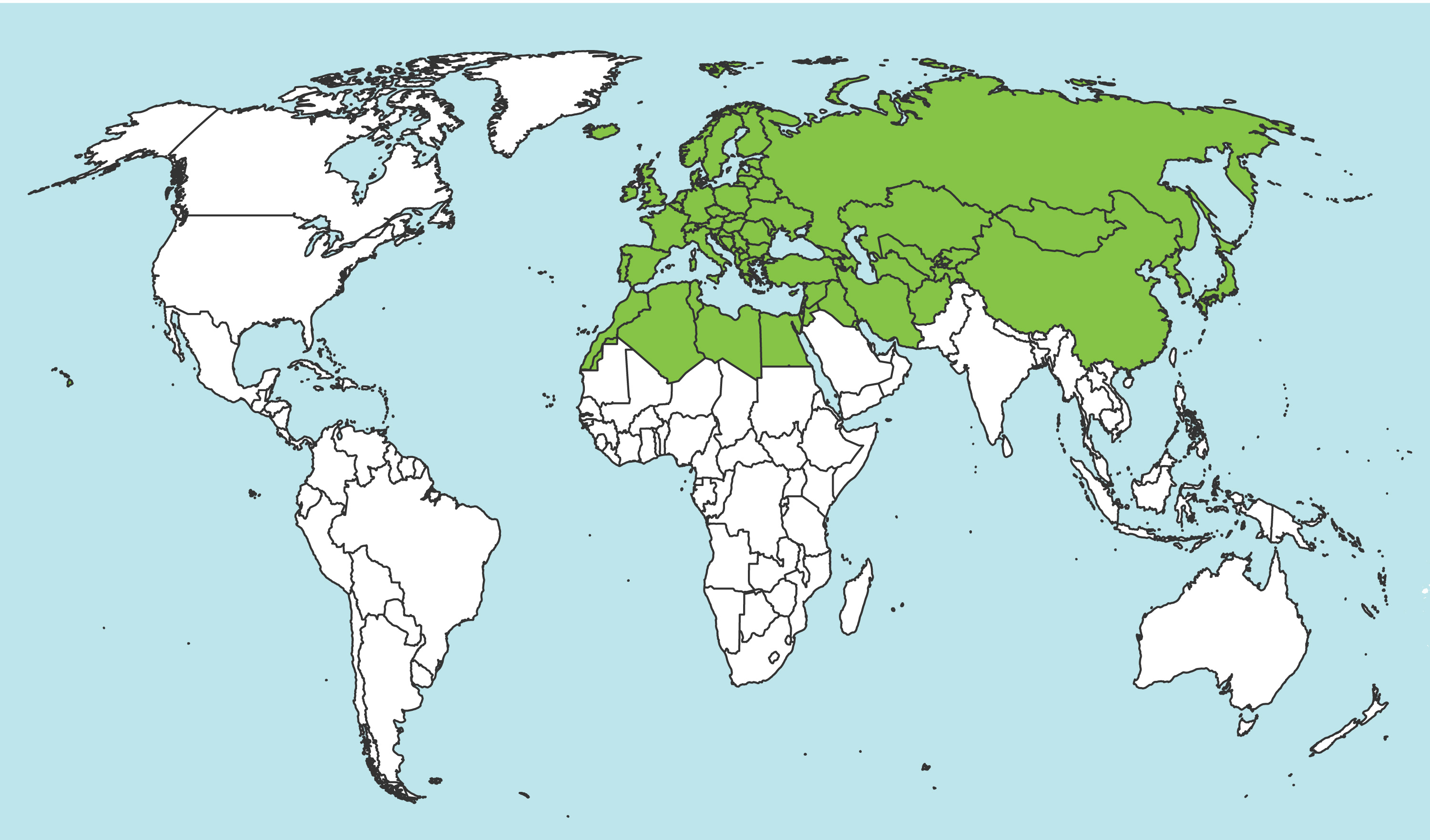Family: Cephidae
Family common name: stem sawflies
Subfamily: Cephinae
Genus: Calameuta Konow, 1896
Subgenera: Calameuta, Ephemerocephus
The Cephidae are commonly known as “stem sawflies” because larvaelarva:
the immature stage of holometabolous insects
 feed and live within the stems of small herbaceousherbaceous:
feed and live within the stems of small herbaceousherbaceous:
describing a plant that does not have a woody stem and is often close to the ground; e.g., grasses, forbs, and vegetable plants
and woody plants. Many are considered pests as this feeding behavior can damage or kill the plant host (Shanower and Hoelmer 2004Shanower and Hoelmer 2004:
Shanower TG and Hoelmer KA. 2004. Biological control of wheat stem sawflies: past and future. Journal of Agricultural and Urban Entomology 21 (4): 197-221.).
Stem sawflies of the genus Calameuta are generally slender, with slightly laterally compressed cylindrical bodies. They have a black head and black body with yellow markings. There is a slight constriction at the second abdominal segment, giving it the gestalt of a wasp (Middlekauff 1969Middlekauff 1969:
Middlekauff WW. 1969. The cephid stem borers of California (Hymenoptera: Cephidae). Bulletin of the California Insect Survey 2: 1-25.). The body length varies from 4–10 mm on average (Benson 1951Benson 1951:
Benson RB. 1951. Handbooks for the identification of British insects - Hymenoptera Royal Entomological Society of London vol. 6 part 2(a).).
Worldwide, there are 23 described species restricted to the Northern Hemisphere. Only two species are known to occur in North America (Taeger et al. 2010Taeger et al. 2010:
Taeger A, Blank SM, and Liston AD. 2010. World Catalog of Symphyta (Hymenoptera). Zootaxa 2580: 1-1064.).
A key to North American species of Calameuta is included in Smith and Schiff 2005Smith and Schiff 2005:
Smith DR and Schiff NM 2005. A new western Nearctic species of Calameuta Konow (Hymenoptera: Cephidae). Proceedings of the Entomological Society of Washington, 107 (4): 864-868..
 and mandibles asymmetrical, larger on the right side (Ries 1937Ries 1937:
and mandibles asymmetrical, larger on the right side (Ries 1937Ries 1937: beyond sixth or seventh segment (Ries 1937Ries 1937:
beyond sixth or seventh segment (Ries 1937Ries 1937: left mandiblemandible:
left mandiblemandible: (Smith and Schiff 2005Smith and Schiff 2005:
(Smith and Schiff 2005Smith and Schiff 2005:Calameuta can be confused with other Cephidae, especially Trachelus and Cephus which were previously in this genus. They can be distinguished from Trachelus by the lack of bristled pits on sternitesternite:
a sclerotized segment of the abdominal sternum
 7 and 8 of the male, and from Cephus by the bidentatebidentate:
7 and 8 of the male, and from Cephus by the bidentatebidentate:
having two teeth; often used in descrbing mandibles or tarsal claws
 left mandiblemandible:
left mandiblemandible:
the primary mouthpart used for biting and chewing; jaw
 and lack of long scale-like setaeseta:
and lack of long scale-like setaeseta:
hair-like structure
on sternitesternite:
a sclerotized segment of the abdominal sternum
 8 of the male. They can be separated from other genera of Cephidae by the presence of preapicalpreapical:
8 of the male. They can be separated from other genera of Cephidae by the presence of preapicalpreapical:
close to, but anterior to, the apex
 spurs on the hind tibiaetibia:
spurs on the hind tibiaetibia:
the fourth segment of the leg, between the femur and the tarsus
 , flagellomereflagellomere:
, flagellomereflagellomere:
A segment of the flagellum of the antenna
 3 subequal to 4, and the distinctly clavateclavate:
3 subequal to 4, and the distinctly clavateclavate:
club-like, thickening toward the tip; often used to describe antennae
 antennaeantenna:
antennaeantenna:
the sensory organ emerging from the front of the head, usually between the compound eyes and above the clypeus; includes the flagellum, scape and pedicel
 beginning past the midpoint (Ries 1937Ries 1937:
beginning past the midpoint (Ries 1937Ries 1937:
Ries DT. 1937. A revision of the Nearctic Cephidae (Hymemoptera: Tenthredinoidea). The American Entomological Society 63 (3): 259-327., Middlekauff 1969Middlekauff 1969:
Middlekauff WW. 1969. The cephid stem borers of California (Hymenoptera: Cephidae). Bulletin of the California Insect Survey 2: 1-25., Smith and Schiff 2005Smith and Schiff 2005:
Smith DR and Schiff NM 2005. A new western Nearctic species of Calameuta Konow (Hymenoptera: Cephidae). Proceedings of the Entomological Society of Washington, 107 (4): 864-868.).
The two species in North America are endemicendemic:
both native and unique to a particular region
. There are no global records of pest species from this genus (Smith and Schiff 2005Smith and Schiff 2005:
Smith DR and Schiff NM 2005. A new western Nearctic species of Calameuta Konow (Hymenoptera: Cephidae). Proceedings of the Entomological Society of Washington, 107 (4): 864-868., Taeger et al. 2010Taeger et al. 2010:
Taeger A, Blank SM, and Liston AD. 2010. World Catalog of Symphyta (Hymenoptera). Zootaxa 2580: 1-1064.).
Few host plants for Calameuta have been confirmed in North America. One hypothesis based on shared range is that this species feeds on wild grasses Bromus laevipes (Chinook brome) and/or Deschampsia danthoniodes (annual hairgrass) (Smith and Schiff 2005Smith and Schiff 2005:
Smith DR and Schiff NM 2005. A new western Nearctic species of Calameuta Konow (Hymenoptera: Cephidae). Proceedings of the Entomological Society of Washington, 107 (4): 864-868.). In Europe, known host plants include grasses such as Alopecurus pratensis (meadow foxtail) Calamagrostis epigejos (bushgrass), Phragmites communis (common reed), Elymus repens (couch grass), Arrhenatherum elatius (false oat grass), and Phalaris arundinacea (reed canary grass) (Benson 1951Benson 1951:
Benson RB. 1951. Handbooks for the identification of British insects - Hymenoptera Royal Entomological Society of London vol. 6 part 2(a).).
Female Calameuta oviposit into larger-diameter stems of grasses (Middlekauff 1969Middlekauff 1969:
Middlekauff WW. 1969. The cephid stem borers of California (Hymenoptera: Cephidae). Bulletin of the California Insect Survey 2: 1-25., Shanower and Hoelmer 2004Shanower and Hoelmer 2004:
Shanower TG and Hoelmer KA. 2004. Biological control of wheat stem sawflies: past and future. Journal of Agricultural and Urban Entomology 21 (4): 197-221.). After hatching, larvaelarva:
the immature stage of holometabolous insects
 feed on the vascular tissue of the plant, moving downwards towards the basebase:
feed on the vascular tissue of the plant, moving downwards towards the basebase:
the beginning or most proximal area of any structure
(Shanower and Hoelmer 2004Shanower and Hoelmer 2004:
Shanower TG and Hoelmer KA. 2004. Biological control of wheat stem sawflies: past and future. Journal of Agricultural and Urban Entomology 21 (4): 197-221.). LarvaeLarva:
the immature stage of holometabolous insects
 are creamy white and grub-like in appearance. They lack abdominal prolegs and have vestigial thoracicthoracic:
are creamy white and grub-like in appearance. They lack abdominal prolegs and have vestigial thoracicthoracic:
of or on the thorax
legs. All Cephidae larvaelarva:
the immature stage of holometabolous insects
 possess a tubular dorsaldorsal:
possess a tubular dorsaldorsal:
of or on the top surface of the body or structure
horn on the posterior end of the body (Middlekauff 1969Middlekauff 1969:
Middlekauff WW. 1969. The cephid stem borers of California (Hymenoptera: Cephidae). Bulletin of the California Insect Survey 2: 1-25.). As they feed, they use this horn to pack frassfrass:
solid larval excrement
in the gallery behind them. At the basebase:
the beginning or most proximal area of any structure
of the plant, the larvaelarva:
the immature stage of holometabolous insects
 girdle the stem above themselves by chewing a V-shaped notch along the inner wall, then pack frassfrass:
girdle the stem above themselves by chewing a V-shaped notch along the inner wall, then pack frassfrass:
solid larval excrement
tightly between themselves and this point. When the plant weakens and dies from the damage, it breaks off at this point and leaves a stub in the ground with a frassfrass:
solid larval excrement
plug on top, keeping the larvalarva:
the immature stage of holometabolous insects
 safe inside (Shanower and Hoelmer 2004Shanower and Hoelmer 2004:
safe inside (Shanower and Hoelmer 2004Shanower and Hoelmer 2004:
Shanower TG and Hoelmer KA. 2004. Biological control of wheat stem sawflies: past and future. Journal of Agricultural and Urban Entomology 21 (4): 197-221.).
Larvae generally undergo a period of diapausediapause:
a non-active period of no development; sawflies often enter diapause as a prepupa or pupa to overwinter
, either over winter or through a dry season, then pupate inside the stub. After about 2 weeks, the adult chews or pushes its way out of the stub and emerges. In cultivated crops, adults generally live for only 7–10 days and are univoltineunivoltine:
describing an insect with a life cycle of one generation per year
(Shanower and Hoelmer 2004Shanower and Hoelmer 2004:
Shanower TG and Hoelmer KA. 2004. Biological control of wheat stem sawflies: past and future. Journal of Agricultural and Urban Entomology 21 (4): 197-221.).
World: The genus is widespread in the PalearcticPalearctic:
describing the region of the northern hemisphere that includes Europe, Asia south to the Himalayas and northern Africa
 region with records throughout Europe east into Russia, south to the Mediterranean (Taeger et al. 2006Taeger et al. 2006:
region with records throughout Europe east into Russia, south to the Mediterranean (Taeger et al. 2006Taeger et al. 2006:
Taeger A, Blank SM, and Liston AD. 2006. European sawflies (Hymenoptera: Symphyta) a species checklist for the countries. pp. 399-504. In: Blank SM, Schmidt S, and Taeger A eds. Recent Sawfly Research mdash; Synthesis and Prospects. Goecke amp; Evers, Keltern.), and in North Africa, Central Asia, China, and Japan (Benes and Holusa 2015Benes and Holusa 2015:
Benes K and Holusa J. 2015. Sawflies (Hymenoptera: Symphyta) in the northeast of the Czech Republic with special regard to spruce forests. Journal of Forest Science 61 (3): 112-130. https://doi.org/10.17221/112/2014-JFS, Discover Life 2019Discover Life 2019:
Discover Life. Accessed January 2019. https://www.discoverlife.org).
North America: The two species of North America are sympatric, both occurring in the Pacific Northwest United States with records in California, Oregon, Washington, and Idaho (Smith and Schiff 2005Smith and Schiff 2005:
Smith DR and Schiff NM 2005. A new western Nearctic species of Calameuta Konow (Hymenoptera: Cephidae). Proceedings of the Entomological Society of Washington, 107 (4): 864-868.).
Map data from: GBIF.org (26 June 2019) GBIF Occurrence Download Calameuta
Details about data used for maps can be found here.